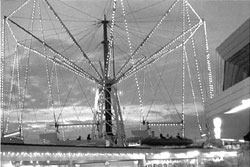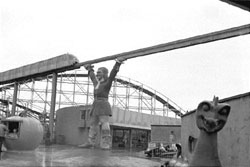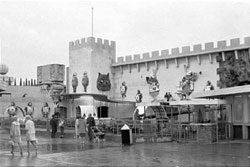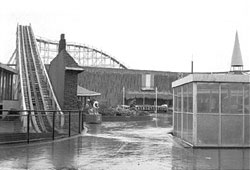|
|
||||||
| HOME ARTICLES GALLERIES ABOUT US FORUM LINKS CONTACT JOYLAND BOOKS | ||||||
|
THE WINDS OF CHANGE: BLACKPOOL PLEASURE BEACH IN THE 1960S by Nick Laister Article: From thegalloper.com, January 2003 |
||||||
|
As a result of a feature on Hiram Maxim we received these
pictures from reader Fred Marshalsea and asked Amusement Park
guru NICK LAISTER to take a trip to the Blackpool Pleasure Beach
of the late 1960s.
|
||||||
|
Last
week, I tried my luck on eBay and bid for a
Blackpool Pleasure Beach souvenir guide from 1970.
This fantastic piece of ephemera focused almost
entirely on the 'new' rides that had been installed
over the last five years. These are rides that we
now very much take for granted when we wander
through the park. And, of course, the park itself
rarely promotes these attractions now,
understandably preferring to talk about the newest
and biggest rides, such as the Big One or Valhalla.
But what was most amazing about reading this booklet
is that almost all of the big new rides of the late
1960s are still running to this day.
I was in the process of trying to imagine a Pleasure Beach of the 1960s, without the towering Pepsi Max Big One, without Avalanche and Revolution and without the huge aircraft hangar that is Valhalla, when through the email popped a message from Dave Page saying that he had been sent some photos of the park from that very period. Dave's timing couldn't have been better. Looking at the photos, it took me back to a park which was surprisingly different from the park of today. Much of the southern end of the park was undeveloped at that time. Leonard Thompson, the father of the present Managing Director Geoffrey Thompson, had become Managing Director of the park in 1933, having bought out the interests of the Outhwaite family two years. This followed the death, in 1929, of park co-founder W.G. Bean (the father of Leonard's wife, Doris). Leonard Thompson had been responsible for what many consider to be the park's golden years, the 1930s, when most of the classic wooden coasters were installed and architect Joseph Emberton changed the face of the park forever. But the 1940s and 1950s had seen the park change very little in comparison, in common with most amusement parks. This was entirely due to the Second World War and the restrictions that followed. All that was to change in the 1960s, as the lifting of the post-war restrictions had meant that Leonard Thompson could embark on a programme of major investment in the park, the first time new attractions had been added since 1939. His vision was to completely upgrade the park and make maximum use of new technology. Rides such as the Wild Mouse coaster and Derby Racer had been added in the late 1950s, but the 1960s were to see the use of materials such as steel and concrete in ways that they could never have been used at the park before. The first ride added in the 1960s was the Turnpike (now called the Grand Prix), an elevated concrete car track that travels across the southern end of the park looking rather like a multi-storey car park. That ride was never the most aesthetic of creations, and has not stood the test of time particularly well. But the following year, a fantastic new dark ride was built at the park, the first such ride for thirty years. Alice's Wonderland, licensed from Walt Disney, took riders along an elevated concrete track (that looked remarkably like the aforementioned Turnpike ride of a year earlier) into an enchanting world of Lewis Carroll's characters. Since the 1960s, railings have been added all around the elevated section, for reasons of rider safety. But otherwise, this ride has changed very little since it was installed (even the spelling mistakes inside the ride remain uncorrected!), and is still popular today. Other big changes in the 1960s were aimed at making travel around the park easier. One of the problems that had dogged the park for years was the road running right through the middle of the park, effectively cutting it into two. This was overcome by the construction, in 1966, of a concrete elevated section across the middle of the park, with ramps to take visitors safely over the road. Also in 1966, Britain's first commercial monorail system opened. This was intended to both assist in transportation around the expanding park, but also as a fun ride in itself, a place where all the park's attractions could be viewed in comfort. The Monorail had four trains, each capable of carrying 60 passengers. One train was enclosed, two were semi-enclosed and one is completely open. The one mile long system had two stations, one by the main car and coach park and the other in the centre of the park. This ride still operates, although it no longer performs a transportation role as only the central station remains open. This was followed by other major rides such as the World's longest Log Flume in 1967 (the first outside of the USA), the Monster (1968, removed 1995) and Astro Swirl (1969, now called the Millennium Bug). Although there was much major development at the park in the 1960s, the old favourites were still very popular. On entering the park back in the 1960s, the first attraction you would have seen was the Noah's Ark ride. This was originally built in 1922, but in the 1930s Joseph Emberton had completely remodelled ride and its animals in a cubist style. However, by the 1960s, this had been replaced by the 'rock' effect that can be seen in the photograph above right. If you look carefully, you can see an elephant, leading a line of animals two-by-two. These animals moved on a track around the rocking Ark. In 1995, this attraction was completely rebuilt to create a new park entrance. The ticket box, which can be seen in the photograph, was moved to the side of the ride, and the moving animals were removed altogether. The huge Hiram Maxim's Flying Machines ride, built in 1904, and the Pleasure Beach's oldest ride, dominated the centre of the park in the 1960s, near the Fun House and Derby Racer. By the 1960s, the planes had been replaced by rockets, as flight had become much more commonplace by then, and the World was captivated by the idea of man travelling into space. Finally, there is a marvellous picture of the entrance to Funshineland (now Beaver Creek), an area set aside for younger visitors. Back in the 1960s, most of this area was taken up by a large children's playground (just to the right of the photograph). At the rear of the park can be seen the Grotto dark ride (now called Magic Mountain), which took children on a voyage of discovery around the world and under the sea. The lift hill of the ever-popular Roller Coaster can clearly be seen to the left of the photograph. The Pleasure Beach of the 1960s was clearly a very different place to the Pleasure Beach of today. As we have seen, the park had entered a period of major change, mainly to turn around the years of stagnation during and following the War. But its only competitors were other attractions in the town, such as the Tower, Winter Gardens and Piers. It would be a further two decades before the Pleasure Beach would have to take on the might of Alton Towers and the other inland theme parks. The rapid development of theme parks in the 1980s and 1990s saw a further wave of development and investment that saw the park build bigger and more spectacular rides. But most of the rides and attractions installed in the 1960s can still be seen amongst these hi-tech machines. Some (such as the Turnpike, due to be upgraded for 2003) look a little worse for wear, with their over-reliance on concrete. But all are worth looking out for on your next visit. To find out more about the development of Blackpool Pleasure Beach, I would recommend the hardback book 'A Century of Fun' by Peter Bennett. I would also recommend two excellent websites: Bits of the Beach, which takes you on a quirky but affectionate tour of the park, and John Burke's Blackpool, which has photographs taken at the park over the last thirty years by a local photographer. |
Welcome to the swinging 60s!
|
|||||
|
||||||
|
|
||||||
|
THEMAGICEYE | Terms and Conditions | Privacy Policy | Contact Us |
||||||






